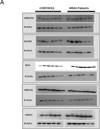The proteome of methylmalonic acidemia (MMA): the elucidation of altered pathways in patient livers
- PMID: 26672496
- PMCID: PMC4858437
- DOI: 10.1039/c5mb00736d
The proteome of methylmalonic acidemia (MMA): the elucidation of altered pathways in patient livers
Abstract
Methylmalonic acidemia (MMA) is a heterogeneous and severe autosomal recessive inborn error of metabolism most commonly caused by the deficient activity of the vitamin B12 dependent enzyme, methylmalonyl-CoA mutase (MUT). The main treatment for MMA patients is the dietary restriction of propiogenic amino acids and carnitine supplementation. Despite treatment, the prognosis for vitamin B12 non-responsive patients remains poor and is associated with neonatal lethality, persistent morbidity and decreased life expectancy. While multi-organ pathology is a feature of MMA, the liver is severely impacted by mitochondrial dysfunction which likely underlies the metabolic instability experienced by the patients. Liver and/or combined liver/kidney transplantation is therefore sometimes performed in severely affected patients. Using liver specimens from donors and MMA patients undergoing elective liver transplantation collected under a dedicated natural history protocol (clinicaltrials.gov: NCT00078078), we employed proteomics to characterize the liver pathology and impaired hepatic metabolism observed in the patients. Pathway analysis revealed perturbations of enzymes involved in energy metabolism, gluconeogenesis and Krebs cycle anaplerosis. Our findings identify new pathophysiologic and therapeutic targets that could be valuable for designing alternative therapies to alleviate clinical manifestations seen in this disorder.
Conflict of interest statement
Marianna Caterino declares that she has no conflict of interest. Randy J. Chandler declares that she has no conflict of interest. Jennifer L. Sloan declares that she has no conflict of interest. Kenneth Dorko declares that she has no conflict of interest. Kristina Cusmano-Ozog declares that she has no conflict of interest. Laura Ingenito declares that she has no conflict of interest. Stephen C. Strom declares that she has no conflict of interest. Esther Imperlini declares that she has no conflict of interest. Emanuela Scolamiero declares that he has no conflict of interest. Charles P. Venditti declares that he has no conflict of interest. Margherita Ruoppolo declares that she has no conflict of interest.
Figures



References
-
- Fenton WA, Gravel RA, Rosenblatt DS. In: The Metabolic and Molecular Bases of Inherited Disease. 8th. Scriver CR, Sly WS, Childs B, Beaudet AL, Valle D, Kinzler KW, et al., editors. New York: McGraw-Hill; 2001. pp. 2165–2192.
-
- de Baulny HO, Benoist JF, Rigal O, Touati G, Rabier D, Saudubray JM. J Inherit Metab Dis. 2005;28:415–423. - PubMed
-
- Van der Meer SB, Poggi F, Spada M, Bonnefont JP, Ogier H, Hubert P, Depondt E, Rapoport D, Rabier D, Charpentier C, Parvy P, Kamoun P, Saudubray JM. J. Pediatr. 1994;125:903–908. - PubMed
-
- Baumgarter ER, Viardot C. J. Inherit. Metab. Dis. 1995;18:138–142. - PubMed
Publication types
MeSH terms
Substances
Supplementary concepts
Associated data
Grants and funding
LinkOut - more resources
Full Text Sources
Other Literature Sources
Medical

